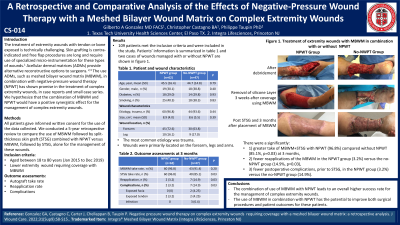Back

Clinical Research
(CR-014) A Retrospective and Comparative Analysis of</span></strong> <strong><span style="font-size: 12.0pt; font-family: 'Times New Roman',serif;">the Effects of Negative-Pressure Wound Therapy with a Meshed Bilayer Wound Matrix on Complex Extremity Wounds

Co-Author(s):
Christopher Castagno, MD; Philippe Taupin, PhD
<b>Introduction</b>: <p class="MsoNormal" style="margin-bottom: 0in; text-align: justify; line-height: normal;"><span style="font-size: 12.0pt; font-family: 'Times New Roman',serif; mso-fareast-font-family: 'Times New Roman';">The treatment of </span><span style="font-size: 12.0pt; font-family: 'Times New Roman',serif;">extremity</span><span style="font-size: 12.0pt; font-family: 'Times New Roman',serif; mso-fareast-font-family: 'Times New Roman';"> wounds</span><span style="font-size: 12.0pt; font-family: 'Times New Roman',serif;"> with tendon or bone exposed</span><span style="font-size: 12.0pt; font-family: 'Times New Roman',serif; mso-fareast-font-family: 'Times New Roman';"> is technically challenging. Skin grafting is contra-indicated and free flap procedures are long, and </span><span style="font-size: 12.0pt; font-family: 'Times New Roman',serif;">require use of specialized micro-instrumentation</span><span style="font-size: 12.0pt; font-family: 'Times New Roman',serif; mso-fareast-font-family: 'Times New Roman';">, for these types of wounds. Acellular dermal matrices (ADMs) provide alternative reconstructive options to surgeons. The use ADMs, such as meshed bilayer wound matrix (MBWM), in combination with </span><span style="font-size: 12.0pt; font-family: 'Times New Roman',serif;">negative-pressure wound therapy (NPWT) has shown promise in the treatment of complex extremity wounds, in case reports and small case series.</span><span style="font-size: 12.0pt; font-family: 'Times New Roman',serif; mso-fareast-font-family: 'Times New Roman';"> We hypothesize that the combination of MBWM and NPWT would have a positive synergistic effect for the management of complex extremity wounds.</span></p><br/><br/><b>Methods</b>: <p class="MsoNormal" style="margin-bottom: 0in; text-align: justify; line-height: normal;"><span style="font-size: 12.0pt; font-family: 'Times New Roman',serif; mso-fareast-font-family: 'Times New Roman';">We conducted a 5-year </span><span style="font-size: 12.0pt; font-family: 'Times New Roman',serif;">retrospective review</span><span style="font-size: 12.0pt; font-family: 'Times New Roman',serif; mso-fareast-font-family: 'Times New Roman';"> to compare the use of MBWM followed by split-thickness skin graft (STSG) combined with NPWT versus MBWM, followed by STSG, alone for the management of these wounds.</span></p><br/><br/><b>Results</b>: <span style="font-size: 12.0pt; line-height: 107%; font-family: 'Times New Roman',serif; mso-fareast-font-family: 'Times New Roman'; mso-ansi-language: EN-US; mso-fareast-language: EN-US; mso-bidi-language: AR-SA;">Data from </span><span style="font-size: 12.0pt; line-height: 107%; font-family: 'Times New Roman',serif; mso-fareast-font-family: Calibri; mso-ansi-language: EN-US; mso-fareast-language: EN-US; mso-bidi-language: AR-SA;">109 patients (62 with NPWT, 47 without NPWT) undergoing management of complex extremity wound coverage with MBWM were reviewed.</span><span style="font-size: 12.0pt; line-height: 107%; font-family: 'Times New Roman',serif; mso-fareast-font-family: 'Times New Roman'; mso-ansi-language: EN-US; mso-fareast-language: EN-US; mso-bidi-language: AR-SA;"> Wounds were primarily located on the forearm, legs, and arms. The most common etiology was trauma.</span><span style="font-size: 12.0pt; line-height: 107%; font-family: 'Times New Roman',serif; mso-fareast-font-family: Calibri; mso-ansi-language: EN-US; mso-fareast-language: EN-US; mso-bidi-language: AR-SA;"> There were: 1) a significant greater take of MBWM+STSG with NPWT (96.8%) compared without NPWT (85.1%, <em>p</em>=0.03), 2) fewer reapplications of the matrix in the NPWT group (3.2%) versus the no-NPWT group (14.9%, p=0.03), and 3) fewer postoperative complications, prior to STSG, in the NPWT group (3.2%) versus the no-NPWT group (14.9%).</span><br/><br/><b>Discussion</b>: <span style="font-size: 12.0pt; line-height: 107%; font-family: 'Times New Roman',serif; mso-fareast-font-family: Calibri; mso-ansi-language: EN-US; mso-fareast-language: EN-US; mso-bidi-language: AR-SA;">The combination of use of MBWM with NPWT leads to an overall higher success rate for the management of complex extremity wounds. The use of MBWM in combination with NPWT has the potential to improve both surgical procedures and patient outcomes for these patients.</span><br/><br/><b>Trademarked Items</b>: Integra Bilayer Wound Matrix<br/><br/><b>References</b>: <br/><br/>

.png)